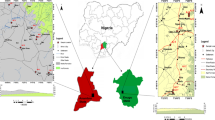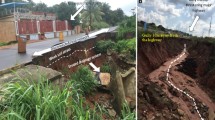Abstract
A strong earthquake of magnitude 8 in Richter scale, occurred in Sichuan Province, China on 12 May 2008, triggered about 257 landslide dams. The erodibility of fresh landslide deposits plays an important role in evaluating the initiation and development of breaching of such landslide dams. In this research, field jet index tests were conducted shortly after the earthquake at 27 locations on the Hongshihe landslide dam and the Libaisi landslide dam. The purpose of these tests was to investigate the erodibility of freshly deposited landslide soils. The landslide deposits are broadly graded. The bulk density increases and the coefficient of erodibility decreases with the depth of deposition. The erodibility of the fresh landslide deposits falls into a moderately resistant category and the fresh deposits are much more erodible than the native geomaterials before the earthquake. The main factors that control soil erodibility are found to be grain-size distribution, void ratio, fines content, and plasticity index. Particularly, the coefficient of erodibility decreases exponentially with the degree of compaction. Two empirical equations are developed for estimating the coefficient of erodibility and critical erosive shear stress of the freshly deposited landslide soils based on their basic soil properties.














Similar content being viewed by others
References
Aderibigbe OO, Rajaratnam N (1996) Erosion of loose beds by submerged circular impinging vertical turbulent jets. J Hydraul Res 34(1):19–33
Allen PM, Arnold J, Jakubowski E (1999) Prediction of stream channel erosion potential. Environ Eng Geosci 5(3):339–351
Annandale GW (2006) Scour technology-mechanics and engineering practice. McGraw-Hill, New York, p 430
Ansari SA, Kothyari UC, Ranga Raju KG (2003) Influence of cohesion on scour under submerged circular vertical jets. J Hydraul Eng 129(12):1014–1019
ASTM D 5852–00 Standard test method for erodibility determination of soil in the field or in the laboratory by the jet index method. Annual Book of ASTM standards, Vol. 04.08
Briaud JL, Ting FCK, Chen HC, Cao Y, Han SW, Kwak KW (2001) Erosion function apparatus for scour rate predictions. J Geotech Geoenviron Eng 127(2):105–113
Briaud JL, Chen HC, Govindasamy AV, Storesund R (2008) Levee erosion by overtopping in New Orleans during the Katrina Hurricane. J Geotech Geoenviron Eng 134(5):618–632
Chang DS, Zhang LM (2010) Simulation of the erosion process of landslide dams due to overtopping considering variations in soil erodibility along depth. Nat Hazards Earth Syst Sci 10:933–946
Chapuis RP, Gatien T (1986) An improved rotating cylinder technique for quantitative measurements of the scour resistance of clays. Can Geotech J 23:83–87
Clark LA, Wynn TM (2007) Methods for determining streambank critical shear stress and soil erodibility: implications for erosion rate predictions. Trans ASABE 50(1):95–106
Costa JE, Schuster RL (1988) The formation and failure of natural dams. Geol Soc Amer Bull 100:1054–1068
Cui P, Zhu YY, Han YS, Chen XQ, Zhuang JQ (2009) The 12 May Wenchuan earthquake-induced landslide lakes: distribution and preliminary risk evaluation. Landslides 6:209–223
Dabbagh AA, González AS, Peña AS (2002) Soil erosion by a continuous water jet. Soil Found 42(5):1–13
Gaskin SJ, Pieterse J, Shafie AAI, Lepage S (2003) Erosion of undisturbed clay samples from the banks of the St. Lawrence River. Can J Civ Eng 30:585–595
Graf WH (1984) Hydraulics of sediment transport. Water Resources Publications, Colorado, p 513
Grissinger EH (1982) Bank erosion of cohesive materials. In: Hey RD, Bathurst JC, Thorne CR (eds) Gravel-bed rivers. John Wiley, New York, pp 624–630
Hanson GJ (1990) Surface erodibility of earthen channels at high stresses part I-open channel testing. Trans ASAE 33(1):127–131
Hanson GJ (1991) Development of a jet index to characterize erosion resistance of soils in earthen spillways. Trans ASAE 34(5):2015–2020
Hanson GJ, Simon A (2001) Erodibility of cohesive streambeds in the loess area of the midwestern USA. Hydrol Process 15:23–38
Howard AD, McLane CF (1988) Erosion of cohesionless sediment by groundwater seepage. Water Resour Res 24(10):1659–1674
Julian JP, Torres R (2006) Hydraulic erosion of cohesive riverbanks. Geomorphology 76:193–206
Kamphuis JW, Gaskin PN, Hoogendoorn E (1990) Erosion tests on four intact Ontario clays. Can Geotech J 27:692–696
Kellerhals R, Bray DI (1971) Sampling procedures for coarse fluvial sediments. J Hydraul Div 97(HY8):1165–1180
Lefebvre G, Rohan K, Douville S (1985) Erosivity of natural intact structured clay: evaluation. Can Geotech J 22:508–517
Lefebvre G, Rohan K, Milette JP (1986) Erosivity of intact clay: influence of the natural structure. Can Geotech J 23:427–434
Mazurek KA, Hossain T (2007) Scour by jets in cohesionless and cohesive soils. Can J Civ Eng 34:744–751
Mazurek KA, Rajaratnam N, Sego DC (2001) Scour of cohesive soil by submerged circular turbulent impinging jets. J Hydraul Eng 127(7):598–606
Mitchener H, Torfs H (1996) Erosion of mud/sand mixtures. Coast Eng 29:1–25
Moore WL, Masch FD (1962) Experiments on the scour resistance of cohesive sediments. J Geophys Res 67(4):1437–1446
Neill CR (1973) Guide to bridge hydraulics. University of Toronto Press, Toronto, p 191
Potter KN, JdeJ V-G, Torbert HA (2002) Use of a submerged jet device to determine channel erodibility coefficients of selected soils of Mexico. J Soil Water Conserv 57(5):272–277
Rajaratnam N (1982) Erosion by submerged circular jets. J Hydraul Div 108(HY2):262–267
Raudkivi AJ (1990) Loose boundary hydraulics. Pergamon Press, New York, p 538
Ren X, Dang YP (2008) Construction organization and construction management for emergency risk-elimination of landslide dams in Qingchuan Country. Chinese Journal of Water Resources and Hydropower Engineering 39(8):27–30, (in Chinese)
Shugar D, Kostaschuk R, Ashmore P, Desloges J, Burge L (2007) In situ jet-testing of the erosional resistance of cohesive streambeds. Can J Civ Eng 34:1192–1195
Smerdon ET, Beasley RP (1961) Critical tractive forces in cohesive soils. Agric Eng 42(1):26–29
Thoman RW, Niezgoda SL (2008) Determining erodibility, critical shear stress, and allowable discharge estimates for cohesive channels: case study in the Power River Basin of Wyoming. J Hydraul Eng 134(12):1677–1687
Wan CF, Fell R (2004) Investigation of rate of erosion of soils in embankment dams. J Geotech Geoenviron Eng 130(4):373–380
Xie HP, Deng JH, Tai JJ, He CR, Wei JB, Chen JP, Li XY (2008) Wenchuan Earthquake and post-earthquake reconstruction-related geotechnical problems. Chinese Journal of Rock Mechanics and Engineering 27(9):1781–1791, in Chinese
Xu C, Dai FC, Yao X, Chen J, Tu XB, Cao YB, Xiao JZ (2010) GIS based certainty factor analysis of landslide triggering factors in Wenchuan Earthquake. Chinese Journal of Rock Mechanics and Engineering 29(Z1):2972–2981, in Chinese
Acknowledgments
The research was substantially supported by the State Key Laboratory of Geohazard Prevention and Geoenvironment Protection (DZJK-0815), the Ministry of Sience and Technology 2009BAK56B05) and the Research Grants Council of the HKSAR (No. 622207). Special thanks are due to Prof. Bixiong Li and Prof. Qun Chen of Sichuan University for their kind assistance during the field tests in the Wenchuan earthquake zone.
Author information
Authors and Affiliations
Corresponding author
Rights and permissions
About this article
Cite this article
Chang, D.S., Zhang, L.M., Xu, Y. et al. Field testing of erodibility of two landslide dams triggered by the 12 May Wenchuan earthquake. Landslides 8, 321–332 (2011). https://doi.org/10.1007/s10346-011-0256-x
Received:
Accepted:
Published:
Issue Date:
DOI: https://doi.org/10.1007/s10346-011-0256-x




